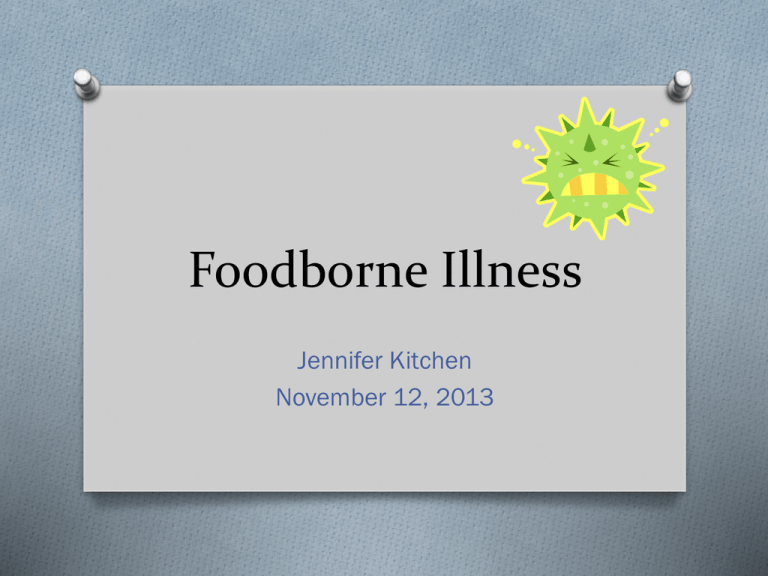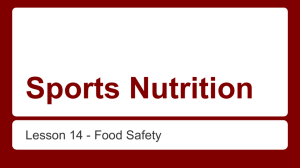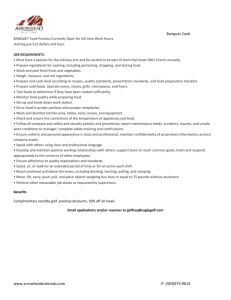Foodborne Illness
advertisement

Foodborne Illness Jennifer Kitchen November 12, 2013 Foodborne Illness O Food Poisoning! O 6 Common Bacteria O 3 Common Toxins O Reportable Conditions O Shigella O symptoms and prevention O Listeria O symptoms and prevention O Food Safety O The Right Way to Wash Your Hands! Food Poisoning! O Foodborne illness O unsafe storage, handling, or preparation O (Schlenker & Roth, 2011) O eating foods that contain O bacterial toxins O viral, chemical, or toxic substances O (Frazier and Dryzmkowski, 2009) 6 Common Bacteria that Cause Foodborne Illnesses O E. coli 0157:H7 O Salmonella O Campylobacter O Vibrio O Shigella O Listeria O (Schlenker & Roth, 2011) 3 Most Common Toxins Found in Food O Staphylococcus aureus O Clostridium botulinum O Clostridium perfringens O (Schlenker & Roth, 2011) CONDITIONS REPORTABLE BY ALL HEALTH CARE PROVIDERS IN COLORADO O Botulism (Clostridium botulinum) O Shigellosis O Listeriosis O Salmonellosis O E. coli 0157:H7 O Shiga toxin-producing E.coli O Group Outbreaks O (Colorado Department of Public Health and Environment (CDPHE), 2012) Shigella O Contamination by food handlers O Vegetables grown in sewage contaminated fields O Food contaminated by flies O Drinking or swimming in contaminated water O (National Institute of Allergy and Infectious Disease (NIAID), 2012) Symptoms O Fever O Tiredness O Watery or bloody diarrhea O Nausea and vomiting O Abdominal pain O (NIAID, 2012) Prevention O Wash hands with soap and water O Before preparing foods and beverages O After using the bathroom O After changing diapers O Disinfect diaper-changing areas O Help young children wash their hands carefully O Avoid swallowing swimming water O (NIAID, 2012) Listeria O Found in soil and water and on animals O Eating contaminated food O Listeria hides in many foods O Found in a variety of raw foods O Can form on cooked foods O Even found in processed/packaged foods O (CDC, 2013) Symptoms O Fever O Chills O Muscle aches O Stiff neck O (CDC, 2013) Prevention O Rinse raw produce thoroughly O Avoid cross-contamination O Keep kitchen clean and safe O Use a refrigerator thermometer O keep fridge at 40°F or lower _ keep freezer 0°F or lower O Clean up spills right away O Cook meats thoroughly O Store foods safely O Choose safer foods O (CDC, 2013) Food Safety O Refrigerate food properly O Wash O Hands _ Foods _ Preparation surfaces _ Utensils O Cook foods to proper internal temperature O Follow storage and handling instructions O Do not use foods if the packaging is damaged O (Schlenker & Roth, 2011) The Right Way to Wash Your Hands O Wet hands with clean running water O Apply soap O Rub hands together to make lather O Scrub well O Continue rubbing your hands for at least 20 seconds. O Rinse hands well under running water. O Dry hands using a clean towel or air dry O (CDC, 2013) References O Center for Disease Control and Prevention. (2010). Estimates of Foodborne O O O O O O Illness in the United States. Retrieved from http://www.cdc.gov/foodborneburden/index.html Center for Disease Control and Prevention. (2013). Wash your Hands. Retrieved from http://www.cdc.gov/features/handwashing/ Center for Disease Control and Prevention. (2013). Listeria (Listeriosis). Retrieved from http://www.cdc.gov/listeria/index.html Colorado Department of Public Health and Environment. (Nov. 30, 2012).Colorado Board of Health Conditions Reportable by All Physicians and Health Care Providers in Colorado. Retrieved from http://www.colorado.gov/cs/Satellite/CDPHE-DCEED/CBON/1251624735712 Frazier, M. S., and Dryzmkowski, J. W. (2009). Essentials of Human Diseases and Conditions (4th Ed.). St. Louis, MO: Saunders Elsevier Inc. National Institute of Allergy and Infectious Diseases. (2012). Shigellosis. Retrieved from http://www.niaid.nih.gov/topics/shigellosis/Pages/shigellosis.aspx Schlenker, E. and Roth, S. (2011). Williams’ Essentials of Nutrition and Diet Therapy. Missouri; Elsevier Mosby.






